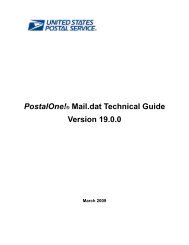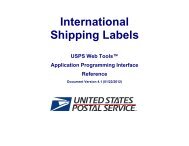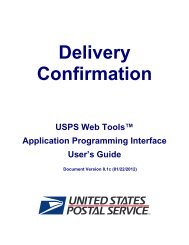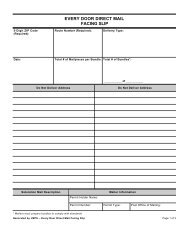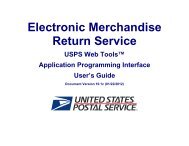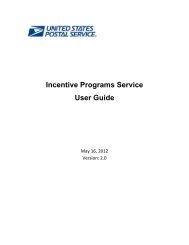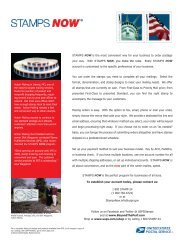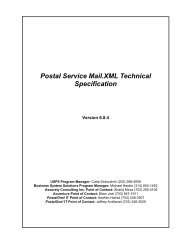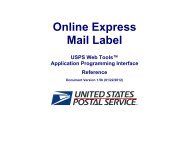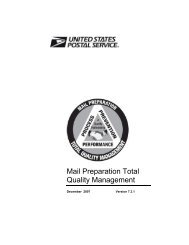Database segmentation - USPS
Database segmentation - USPS
Database segmentation - USPS
Create successful ePaper yourself
Turn your PDF publications into a flip-book with our unique Google optimized e-Paper software.
<strong>Database</strong> <strong>segmentation</strong>:<br />
How you use it makes all the di� erence.<br />
Segmentation Primer – Classifying Customers<br />
You can identify and segment customers based on<br />
literally any available data. There are a few proven effective<br />
<strong>segmentation</strong> types that can be employed. The robustness<br />
of your data often determines the types of <strong>segmentation</strong><br />
you should use. There are four main <strong>segmentation</strong> methods:<br />
� Demographic Segmentation<br />
Almost every database contains demographic information<br />
about customers. Demographic information is nothing<br />
more than an identifying characteristic within a given<br />
population. These can be things like age, gender, ethnicity,<br />
income, family or marital status, educational background,<br />
and so on.<br />
Pros: Readily available, easily defined, simple to implement<br />
Cons: Offers only basic differentiations; does not involve<br />
customer mind-set, purchase history, or other preferences<br />
Direct Mail note: You can also segment by ZIP Code.<br />
� Attitude Segmentation<br />
To segment on attitudes, you must first find out what they<br />
are. This involves the “psychographic profile” of a customer.<br />
Asking a series of questions can provide valuable information<br />
about what your customer thinks about your product,<br />
service, and company.<br />
Pros: Includes customer thought processes, is more<br />
focused than demographic <strong>segmentation</strong>, allows for more<br />
detailed messaging strategy<br />
Cons: Samples are not necessarily an accurate representation<br />
of the attitudes of the entire database, may require the<br />
addition of other <strong>segmentation</strong> techniques to achieve best<br />
results, customer attitudes can change quickly<br />
Direct Mail note: Reply cards, mailed surveys, and coupon<br />
questionnaires are all effective ways to incentivize customers<br />
to share their information through the mail.<br />
� Behavior Segmentation<br />
You can use your customers’ history with your company<br />
to define their behavior. What did they buy? What didn’t<br />
they buy? When did they buy, how often did they buy it,<br />
and from where? Who else do they buy from? Research can<br />
even reveal why customers buy products and services the<br />
way they do. Based on this behavioral information, you can<br />
surmise what products to develop and how to market<br />
them more effectively.<br />
Pros: Reveals customer motivation, focuses on customers<br />
who are likely to make a purchase, provides marketers with<br />
reliable prospects, can be used to determine customer value<br />
Cons: Does not address new customers, customer<br />
motivations can vary widely, not all behavior is a reliable<br />
indicator of customer habit or loyalty<br />
Direct Mail note: A mailed coupon or similar promotion is<br />
an excellent way to discern what will motivate a customer,<br />
and with Direct Mail, different promotions can be tested<br />
across a segment.<br />
� Benefits Segmentation<br />
Also known as “needs-based<br />
<strong>segmentation</strong>,” this type of<br />
<strong>segmentation</strong> states that<br />
customers in different<br />
benefit segments have<br />
different needs.<br />
Companies can<br />
assign benefits<br />
to products and<br />
then segment<br />
customers<br />
based on which<br />
benefits they’re<br />
drawn to. Some customers will fit into multiple benefits<br />
segments, while others may have a unique need.<br />
Pros: Addresses customers’ needs, uses relevant product<br />
data to classify customers, helps create a clear marketing<br />
message, gives customers what they want<br />
Cons: May not take customer loyalty or other factors into<br />
account, requires a robust database, can be a “trial and<br />
error” process<br />
Direct Mail note: Benefits <strong>segmentation</strong> can be efficiently<br />
tested using Direct Mail, thanks to its measurability.<br />
Whether you have a lot of customer data or very little, you<br />
can segment your customer base to create more effective<br />
communications. The key to successful segmenting is to<br />
focus on a few reliable commonalities within the segment.<br />
Trying to apply too many characteristics can fragment<br />
segments beyond usefulness or make them too complex<br />
and narrow to use effectively. In addition, the more traits<br />
you assign to a segment, the more likely that customers<br />
will change, rendering the segment obsolete.<br />
By combining different types of <strong>segmentation</strong>, a<br />
few vital shared characteristics can<br />
be determined and used to<br />
improve the efficiency<br />
and effectiveness of<br />
a Direct Mail CRM<br />
program, and Direct<br />
Mail can, in turn,<br />
improve your<br />
<strong>segmentation</strong><br />
as well.<br />
Insight<br />
1<br />
Relevant messages, better results<br />
When building a CRM program with Direct Mail, many<br />
companies use a very broad message that can be understood<br />
by a wide audience. They assemble lists with as many likely<br />
customers as possible, and they send as many pieces as<br />
they can. The average response to such messages is<br />
generally low, simply because the message itself is<br />
irrelevant to the majority of those viewing it.<br />
In contrast, a well-segmented customer list allows you to:<br />
• Craft relevant messages to an interested audience<br />
• Target messages to high-value customer segments and<br />
personalize content<br />
• Forecast response more accurately<br />
• Predict a segment’s value for future mailings<br />
Alan Rosenspan, president of Alan Rosenspan & Associates,<br />
cites on his website (alanrosenspan.com) the bene� ts<br />
of relevant messaging at the top of his list of important<br />
factors to improve response, determine the customers<br />
who are most likely to respond, and send them a relevant<br />
message. “You don’t want to try to sell swimming pools to<br />
people who live in apartments.”<br />
Segmentation allows companies to maximize e� ectiveness<br />
by focusing on customers who are most receptive to the<br />
message. Relevant, timely messaging will strengthen loyalty<br />
and create advocates for products and services.<br />
The take-away: Segmentation o� ers you the<br />
opportunity to develop marketing messages that are<br />
more relevant to your intended recipients. Because it<br />
provides you with the insights needed to create speci� c<br />
messages – including personalized messages – and to<br />
include information relevant to the individual customer,<br />
<strong>segmentation</strong> can vastly increase the e� ectiveness of<br />
your Direct Mail.
Insight<br />
2<br />
Segmentation increases<br />
Direct Mail e� ciency<br />
There are obvious bene� ts of <strong>segmentation</strong> to Direct Mail<br />
e� ciency. There are many ways that this e� ciency can be<br />
realized, depending on a given company’s methodology.<br />
� Get the desired result using fewer mail pieces – Sending<br />
a more relevant message to fewer customers means<br />
you can achieve results on par with larger, less targeted<br />
campaigns. However, <strong>segmentation</strong> is not really intended<br />
to reduce your investment in marketing – it represents the<br />
opportunity to get the most out of marketing dollars.<br />
� Mail the same number of pieces with better response –<br />
Instead of cutting back, you might send the same number<br />
of pieces, but target speci� c segments with di� erent<br />
messages. More relevant messages usually see more<br />
response, which drives up your ROI. Personalization adds<br />
extra oomph.<br />
� Focus on high-value customers – Segmentation lets<br />
you identify and focus on the customers who are most<br />
lucrative. This can lead to bigger returns on your investment.<br />
Andy Wright, President of Brand Loyalty at Carlson Marketing,<br />
sees <strong>segmentation</strong> as an obvious approach for direct<br />
marketers. “In this multi-channel world, the marketer has<br />
many options. Direct Mail is one that can be useful in reaching<br />
higher-value segments. A strong o� er presented in a creative<br />
way to a highly segmented audience breaks through the<br />
clutter and has the potential to make a great impact. Lowervalue<br />
prospects can be pitched through lower cost methods.”<br />
The take-away: Your company can use <strong>segmentation</strong><br />
to take full advantage of the versatility of Direct Mail –<br />
especially in CRM. Segmentation combined with Direct<br />
Mail enables you to spend marketing dollars where<br />
they will conceivably do the most good and gives your<br />
company options to approach customers given<br />
your budget.<br />
Insight<br />
3<br />
Improving Segmentation with Direct Mail<br />
Direct Mail is a perfect � t with <strong>segmentation</strong> because of its<br />
powerful targeting and analytical abilities. When you begin<br />
segmenting your database, a great deal of trial and error<br />
can be involved. Often, it may be di� cult to ascertain the<br />
ideal segments immediately due to insu� cient data, poor<br />
data upkeep, or simply having too much data to analyze.<br />
Direct Mail o� ers you a perfect venue to test and identify<br />
segments. Because Direct Mail can be sent to samples of<br />
nearly any size, you can use it to test segments before<br />
dedicating more marketing dollars to them. This allows<br />
you to test the waters, so to speak, to � nd out if your<br />
<strong>segmentation</strong> is accurate. Better <strong>segmentation</strong> leads to<br />
more e� ective Direct Mail, which leads to better<br />
<strong>segmentation</strong>, and so on.<br />
Furthermore, Direct Mail can aid in <strong>segmentation</strong> by<br />
helping you collect and compile relevant customer data.<br />
Including questions on a reply card or a short survey,<br />
o� ering multiple choices for ful� llment, and even sending<br />
customers to a website are ways that Direct Mail can open<br />
a channel of information from your customers. With more<br />
information, you can uncover newer, larger, and even<br />
more pro� table segments.<br />
The take-away: Segmentation and Direct Mail are<br />
excellent partners because each builds on the strength<br />
of the other. Good <strong>segmentation</strong> can drastically<br />
increase the e� ectiveness of a Direct Mail program,<br />
while Direct Mail o� ers many ways you can gather<br />
more information to increase the e� ectiveness of your<br />
<strong>segmentation</strong> e� orts. By taking advantage of this<br />
binary relationship, you can achieve outstanding results.
It’s no secret that big companies often don’t do well when<br />
making overtures to small businesses. In many instances,<br />
their outreach efforts fail not because big businesses<br />
don’t have anything worthwhile to offer but because<br />
major marketers aren’t very good at holding the attention<br />
of small entrepreneurs.<br />
But a recent, award-winning campaign by Verizon did<br />
indeed capture the fancy of many small businesses –<br />
and earned some notice from the big boys too, for both<br />
its effectiveness and its simplicity.<br />
In fall 2006, the telecom giant began sending out a test<br />
mailing of Direct Mail pieces that bore a striking resemblance<br />
to an all-too-familiar office-supply staple – the interoffice<br />
envelope. Verizon targeted 11,851 small businesses with the<br />
envelopes, which featured the words “INTERNET NOTICE”<br />
stripped across the top and the crossed-out names of<br />
fictitious previous recipients. A final “name” – “Cable User” –<br />
was unobscured, a cue for business owners to “cross out”<br />
their cable provider and switch to a high-speed digital<br />
subscriber line (DSL) provided by Verizon.<br />
Deliver® magazine reprint<br />
The envelope was accompanied by a cover letter – with<br />
the heading “For Speed, For Features, For Price…Verizon<br />
Business DSL” – that was signed by Verizon small business<br />
marketing director Marquita Carter.<br />
In an interview, Carter explains that Verizon officials settled<br />
on the three-month “Interoffice Envelope” campaign after<br />
tests suggested its simple familiarity stood a strong chance of<br />
cutting through the promotional clutter that confronts many<br />
small businesses.<br />
“The iconic look of an interoffice envelope – who’s going<br />
to just toss that out?” asks Carter rhetorically. “We tested this<br />
approach and got some really strong results. It bettered our<br />
control number by 30 percent.”<br />
Carter says a test is part of every Direct Mail campaign at<br />
Verizon. The company sends out two or more different<br />
pieces of Direct Mail and measures which one generates<br />
the most calls and conversions to sales. The responses are<br />
benchmarked against the control campaign, which is the<br />
best campaign from the last Direct Mail cycle.<br />
Continued
But even before they decided on the campaign, she says,<br />
marketers at Verizon were investing considerable time and<br />
research into small businesses, a segment that spends more<br />
than $5 trillion annually on goods and services, according<br />
to the most recent federal numbers. Like many big<br />
businesses, the $90 billion communications company is<br />
continually looking for new inroads into the mom-andpop<br />
market.<br />
“We put a lot of time, energy and research into understanding<br />
what makes them tick, what keeps owners up at night and<br />
what are the approaches that are really going to get their<br />
attention,” explains Carter. “We’re always testing and trying<br />
to find ways using Direct Mail to get the attention of a small<br />
business owner.”<br />
Such research is what helped Verizon’s business marketing<br />
team decide to target a select group of businesses with the<br />
Interoffice Envelope campaign. Rather than take a scattershot<br />
approach, Verizon targeted small businesses with particular<br />
connectivity needs, promoting services like its rapid FiOS<br />
Internet connection to companies that handle matters such<br />
as engineering designs, financial documents, X-rays, legal<br />
files and data backups.<br />
“Our focus is on what we consider a sweet spot – small<br />
businesses with fewer than 10 employees, businesses that<br />
really form the backbone of the U.S. economy, businesses<br />
that really have a need for high-speed Internet,” says Carter.<br />
That focus partly helped Verizon capture a 2007 ECHO<br />
Award for the “Interoffice Envelope” campaign at the Direct<br />
Marketing Association conference last year.<br />
“We felt terrific about winning the award,” says Carter. “It’s<br />
always good to have your work rewarded. It showed how<br />
we moved the needle. It wasn’t just about pretty pictures.”<br />
And while Carter says that Verizon uses a variety of media to<br />
get the attention of small business owners, Direct Mail will<br />
remain a constant in its messaging efforts. “It may vary from<br />
quarter to quarter, but we always have a constant stream of<br />
Direct Mail going to small businesses,” Carter notes. “It’s one<br />
of the most efficient ways to reach them.” D<br />
Originally published June 12, 2008, on delivermagazine.com<br />
09SUPSHT469



